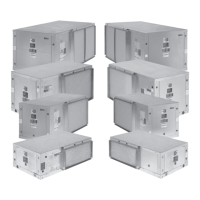Table 7. Recommended line sizes
c
1
vi-1
5/a
2%
1%
15.3 23.6
IYe-
% 2%
1
‘/s
18.5
29.1
14.7 29.0
t
17.9 35 3
1%--15/g
a!¶
1
‘/a
t
5/8-2’/8
25/n
%
15/s--2’h 2%
1%
16.6 37.6
15h--2’h
2%
1
YE
16.6 37.6
1%
33.2
48.9
t
%-2’/a
1%-2%
2% 1%
36.1 56.1
t5/8-2’/!¶
I$
2%-25/s 3%
1%
33.0
56.9
2’/8-2%
irr:
.%-25/n
3% 1%
33.4 66.7
2’%-2%
tc
I 2%-25/n
I
3%
t
% 33.9 73.6
2%-25/e
E
f
2%-25/e
I
3%
1%
37.9
82.5
2%-25/s
3%
1
=/n
34.4 90.4 2%-25/a
~,I
,
II
,
.”
._
,
3’/a
1%
C
3%
I
2%
I
35.9
99.6
1
2+-31/s
I
35/s
2%
w
1
Wi-3%
1
3%
1
2%
1
40.0
111.1
1
Wi-3%
1
3% 2%
NOTES:
Recommended line sizes shown in the above table are based on the unit
for oil entrainment should be checked and where necessary double
suc-
operating conditions between 40°F and 45°F saturated suction temperature
tion risers should be utilized. See Table 5.
page
6.
and condenser entering air temperature of 95°F. per 100 ft. equivalent length
of tubing. When design conditions vary, the table values should be rechecked.
1. Liquid and suction lines based on a recommended equivalent pressure
drop of 2°F (3 psi for suction line, 6 psi for liquid line) per 100 ft. of
equivalent length.
4.
5.
2. When refrigerant required to charge a circuit exceeds the
pumpdown
capacity of that circuit the use of a separate refrigerant storage receiver
will be required. The pumpdown capacity (shown in Table 10) is based
on the condenser 90% full at 90°F.
3.
Wherever vertical rise occurs in the suction piping, the minimum tonnage
6.
Table 8. Liquid line accessory kits (when supplied by McQuay)
Wherever vertical rise occurs in the suction piping on a system
with
hot
gas bypass, double suction risers may not be needed as the velocity of
suction gas is increased at minimum load conditions.
Total equivalent feet for a given piping layout must include the equivalent
length of straight pipe for fittings, valves and specialties added to the total
run of straight pipe.
Piping design,
sizing
and installation information presented in
ASHRAE
Handbooks should, where applicable, be followed in the design and In-
stallation of piping.
886-580896A-06
.” ,”
i
886~580896A-09 1%
1
‘/a
886~580896A-10
1
‘/s
1
‘/s
l&2
886-580896A-10
1%
l’/a
l&2
886-580896A-11
1%
1%
I
23oc
182
886~580896A-11
1%
1%
NOTE:
%
Larger capacity expansion valve in liquid line accessory kit is used for
circuit
#2.
,-
,_
._
1
‘/a
1
‘/a
1
Yi
1
‘h
1
‘/a
1%
1
‘h
1
‘/a
1%
1%
1
‘h
1%
t
‘/s
1
‘/a
1%
LIQUID LINE COMPONENTS
McQuay has available a “Liquid Line Accessory Kit” for each
ALP unit size. The kit does not include tubing. Table 8 shows
the ordering number to be used for each ALP unit size. The
components in these kits are:
1. Sealed core filter-driers (ALP-170 thru 230C have
replaceable core filter-driers).
2. Refrigerant solenoid valves.
3. Refrigerant
sightglass/moisture indicators.
4. Expansion valves (one per circuit).
HOLDING CHARGE
The Model ALP condensing unit is shipped with a holding
charge of refrigerant. At the time the unit was received a visual
inspection of the unit piping should have been made to be
sure no breakage had occurred or that fittings might have
been loosened. A pressure check should indicate a positive
pressure in the unit. If no pressure is evident, the unit will
have to be leak tested and the leak repaired. This should be
Page 8
/
IM 269
noted and reported to your McQuay sales representative or
freight carrier if the loss is due to shipping damage.
PRESSURE TESTING
No pressure testing is necessary unless damage was in-
curred during shipment or rigging. Damage may be deter-
mined by a visual inspection of the exterior piping assuming
no breakage has occurred or fittings have loosened. Pressure
gauges should show a positive pressure. If no pressure is
evident on the gauges, a leak has probably occurred releas-
ing all or part of the refrigerant charge. In this case, the unit
should be leak tested to locate the leak.
LEAK TESTING
In the case of loss of the refrigerant holding charge, the unit
should be checked for leaks prior to charging the complete
system. If the full charge was lost, leak testing can be done
by charging the refrigerant into the unit to build the pressure

